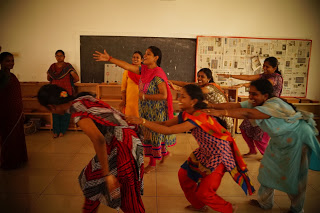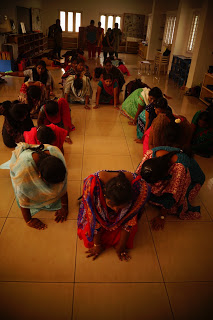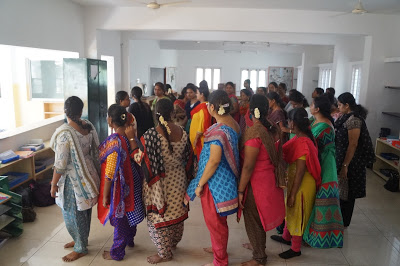In our year long engagement with Kamala Niketan , Trichy we are working with the teachers in the schools to see how together we can look at arts as a tool to impart academic learning in classrooms. It has meant a lot of questioning, challenging existing methodologies and more importantly experiencing what these art forms do to us. Working in collaboration with classroom teachers, the group was introduced to use creative movement in the classroom to teach across the curriculum. By asking students to respond to material nonverbally and experience the curriculum through their bodies, we encourage new levels of self-discovery and self-expression.
It’s truly astonishing that the dominant model for formal learning is still “sit and git.”The area of the brain most associated with motor control is the cerebellum. It’s located in the back of the brain, just under the occipital lobe, and is about the size of a small fist. The cerebellum takes up just one-tenth of the brain by volume, but it contains nearly half of all its neurons (Ivry & Fiez, 2000). This structure, densely packed with neurons, may be the most complex part of the brain. In fact, it has some 40 million nerve fibers—40 times more than even the highly complex optical tract. Those fibers feed information from the cortex to the cerebellum, and they feed data back to the cortex. In fact, most of the neural circuits from the cerebellum are “outbound,” influencing the rest of the brain (Middleton & Strick, 1994). Peter Strick at the Veteran Affairs Medical Center of Syracuse, New York, has documented another link. His staff has traced a pathway from the cerebellum back to parts of the brain involved in memory, attention, and spatial perception.
Amazingly, the part of the brain that processes movement is the same part of the brain that processes learning .
Some of the smartest things teachers can do are the simplest. When we keep students active, we keep their energy levels up and provide their brains with the oxygen-rich blood needed for highest performance. Educators should purposefully integrate movement activities into everyday learning: not just hands-on classroom activities, but also daily stretching, walks, dance, drama, seat-changing, energizers, and physical education. “Classroom teachers should have kids move for the same reason that P.E. teachers have had kids count” (personal communication, 1997).Brain-compatible learning means that educators should weave math, geography, social skills, role-play, science, and physical education together, along with movement, drama, and the arts.
With all the research and documentation of the critical and effective use of kinesthetic learning in the curriculum, it is imperative that we change the paradigm of how this essential learning strategy is viewed. In fact , kinesthetic teaching should be a fundamental part of teacher-training, and its varied techniques should be incorporated in the teaching toolbox, particularly at the elementary school level . Teachers who embrace kinesthetic teaching often find their own creativity stirred anew, and deepen their own appreciation of subject matter as they look for those aspects of a topic that lend themselves to movement-based lessons. Teachers need not be dancers or even comfortable with their bodies to have such insights and to use kinesthetic techniques. Teachers always need to be courageous, but never more so than in these days of transition and conflict in education.
STANDING UP, literally, can be a first step toward restoring vitality to classrooms.
Source: SnehadharaBlog



